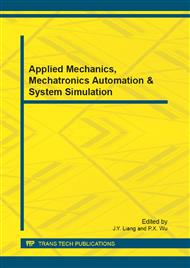[1]
E.W. Dijkstra, A note on two problems in connection with graphs, Numerische Mathematik, 1959. 1269-271.
Google Scholar
[2]
A. Aggarwal, B. Schieber, and T. Tokuyama. Finding a minimum weight K-link path in graphs with Monge property and applications. Proc. 9th Symp. Computational Geometry, Assoc. for Computing Machinery, 1993. 189–197.
DOI: 10.1145/160985.161135
Google Scholar
[3]
D. Wagner and T. Willhalm. Geometric Speed-Up Techniques for Finding Shortest Paths in Large Sparse Graphs. In European Symposium on Algorithms, (2003).
DOI: 10.1007/978-3-540-39658-1_69
Google Scholar
[4]
Fang Hui, Hong Weijun, Shortest Path Algorithm within Dynamic Restricted Searching Area in City Emergency Rescue[J], Journal of Chinese People's Public Security University(Science and Technology), 2010. 4(4): 87-91.
DOI: 10.1109/icemms.2010.5563425
Google Scholar
[5]
Fang MeiHong, Liu ShaoHua. The Design and Realization of the shortest path Algorithm Based on VC++. [J] Urban Geotechnical investigation & surveying, 2008. 1: 43-46.
Google Scholar
[6]
Lin X, Shroff N B. Utility maximization for communication networks with multi-path routing[C]. IEEE Trans Automat Contr, 2006: 766-781.
DOI: 10.1109/tac.2006.875032
Google Scholar
[7]
S. Xing, C. Shahabi, and B. Pan. Continuous monitoring of nearest neighbors on land surface. PVLDB, 2(1): 1114–1125, (2009).
DOI: 10.14778/1687627.1687753
Google Scholar
[8]
ZHANG Jin-ming, HONG Gang, WEN Rui, et al. Optimization strategies of the Dijkstra's shortest route algorithm[J]. Science of Surveying and Mapping, 2009, 34(5): 105-106.
Google Scholar
[9]
CAO Jiandong, ZHENG Sifa,WANG Jianqiang, et al. Fast synchronous optimization algorithm for pickup and delivery route[J]. Journal of Tsinghua University (Science and Technology), 2008, 48 (8) : 1344-1347.
Google Scholar
[10]
Zhang Fuhao, Liu Jiping. A new shortest path algorithm for massive spatial data based on Dijkstra algorithm[J]. Journal of LiaoNing Technology University: (Natural Science and edition), 2009, 28(4): 554-557.
DOI: 10.1109/fskd.2009.848
Google Scholar


